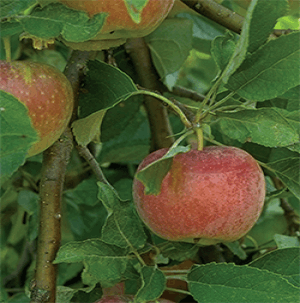By Richard Jauron
Soon, it will be time for apple trees to bloom and bear delicious fruit for all to enjoy. But not all apple trees are fruitful. Why are some trees more productive than others? There are several reasons worth exploring.

Iowa State University Extension and Outreach horticulturists can help answer queries regarding apple trees and their fruitful nature. To have additional questions answered, contact the ISU Hortline at 515-294-3108 or hortline@iastate.edu.
In regards to tree fruits, what is meant by the term self-unfruitful?
Pollination is the transfer of pollen from the anther to the stigma. After pollination and fertilization, fruit set occurs. There are two types of pollination. Self-pollination occurs when the pollen is transferred from the anther to the stigma on the same flower, from another flower on the same plant or from a flower on another plant of the same cultivar.
Self-pollinated plants are said to be self-fruitful. Many plants cannot produce fruit from their own pollen and are considered self-unfruitful. These plants require cross-pollination for fruit set. Cross-pollination is the transfer of pollen from one plant to the flower of a genetically different plant or cultivar.
Is it necessary to plant two different apple cultivars for fruit set?
Pollination requirements are an important factor when planting tree fruits in the home garden. Apples are regarded as self-unfruitful. Most apple cultivars will set a small crop with their own pollen. However, for maximum production, plant at least two different apple cultivars within 50 to 100 feet of one another to ensure cross-pollination and fruit set.
Will a crabapple pollinate a nearby apple tree?
A crabapple is a type of apple. The main difference between an apple and a crabapple is the size of the fruit. A crabapple is a tree that produces fruit that are less than 2 inches in diameter. An apple tree produces fruit that are larger than 2 inches in diameter. Most flowering crabapples will pollinate nearby apple trees.